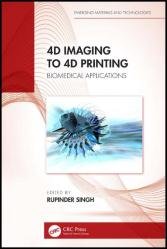4D Imaging to 4D Printing: Biomedical Applications
- Добавил: literator
- Дата: 18-11-2022, 06:30
- Комментариев: 0
 Название: 4D Imaging to 4D Printing: Biomedical Applications
Название: 4D Imaging to 4D Printing: Biomedical ApplicationsАвтор: Rupinder Singh
Издательство: CRC Press
Год: 2023
Страниц: 168
Язык: английский
Формат: pdf (true)
Размер: 25.3 MB
This book focuses on applications of 4D imaging and 4D printing for development of low-cost, indigenous lab-scale solutions for various biomedical applications. It is based on a selection of benchmark open-source 4D imaging solutions including the effect of different stimulus (such as light, electric field, magnetic field, mechanical load, thermal, hydro, and so forth) to better understand 4D capabilities of printed components. The material is covered across nine chapters dedicated to 4D imaging, 4D printing, and their specific biomedical applications illustrated via case studies related to orthopaedic and dental requirements of veterinary patients.
The engineering processes are divided into two categories: forward and reverse engineering. Forward engineering is the established process where logical designs with high-level abstractions are physically implemented in a well-planned system to develop a product. This may or may not include a detailed drawing with a list of materials and raw data processing for developing a new physical product. The desire to accelerate advanced intelligence and to have interdisciplinary access to new complexities has led to the establishment of modern additive manufacturing (AM) technology that uses digital blueprints such as computer-aided design (CAD) models. On the other hand, reverse engineering is the duplication of an existing product that includes the systematic joining of point clouds for the development of a meaningful virtual model through 3D scanning and CAD modeling.
3D printing initiated research into applications ranging from biomedical to electronics and, most prominently, in biomimetics and smart materials for the advantages of convenience and adept object production, thanks to the effectiveness of material usability, surface resolution, and finely tuned design. The static and inanimate existence of the printed object, including the anisotropic behavioral patterns of the technology, acted as a barrier in printing technology, which was eliminated by 4D printing, which added a temporal dimension to 3D concepts and offered substance to the design by using a stimulus to trigger transfiguration into smart materials.
The book:
- Presents exclusive material on the integration of 4D imaging and 4D printing
- Demonstrates the industrial applications of 4D imaging in 4D printing using multiple case studies
- Discusses use of open-source 4D imaging tools for biomedical applications
- Includes in-house development of smart materials for 4D printing
- Reviews low-cost, indigenous lab-scale solutions for various veterinary applications.
This book is aimed at graduate students and researchers in Additive Manufacturing, Manufacturing Engineering, Production Engineering, Mechanical Engineering, and Materials Engineering.
Скачать 4D Imaging to 4D Printing: Biomedical Applications
[related-news] [/related-news]
Внимание
Уважаемый посетитель, Вы зашли на сайт как незарегистрированный пользователь.
Мы рекомендуем Вам зарегистрироваться либо войти на сайт под своим именем.
Уважаемый посетитель, Вы зашли на сайт как незарегистрированный пользователь.
Мы рекомендуем Вам зарегистрироваться либо войти на сайт под своим именем.
